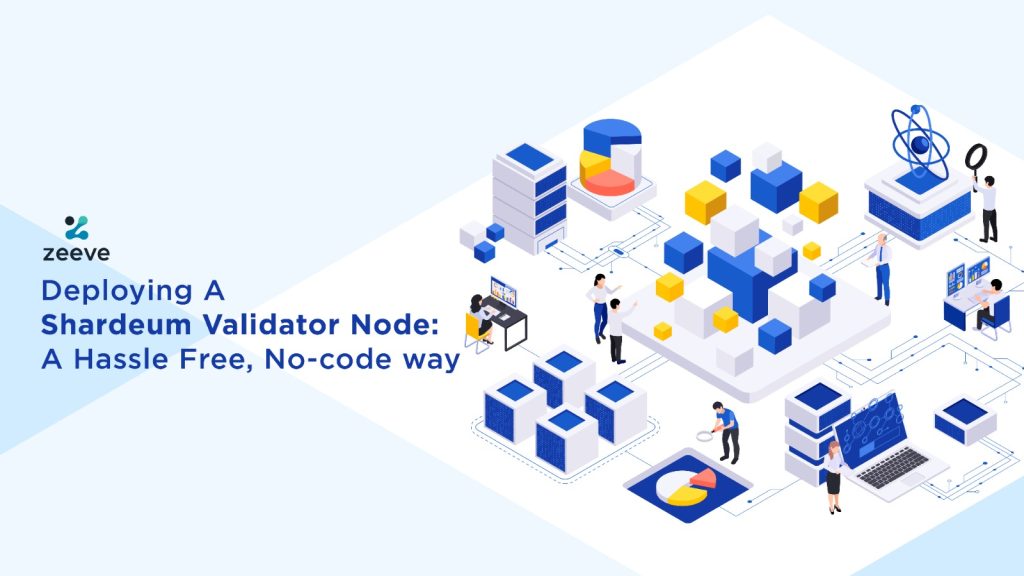As a fastest-scaling, highly feasible Layer-1 blockchain, Shardeum offers a linearly scalable and truly decentralized ecosystem for building future-proof smart contracts and dApps. The platform recently achieved overwhelming success on Shardeum Liberty and evolved into Shardeum Sphinx 1.X. As a result, a large number of web3 investors and institutions have been showing strong interest to become validators on Shardeum to participate in DAO, earn rewards and maximize their staking yield.
However, setting up and running staking nodes requires validators to have technical skills and certain hardware specifications. Unlike the conventional coding-based approach, this guide talks about a simplified, no-code approach to Shardeum validator node deployment that allows anyone to run validators on Shardeum Sphinx to earn rewards and participate in the Shardeum’s consensus without needing heavy hardware requirements or sound technical expertise.
Quick rundown on Shardeum Network
Shardeum is an EVM-based, high-performing smart contract platform designed to solve blockchain’s scalability trilemma while maintaining unparalleled security and enabling low gas fee features. Along with the launch of Sphinx 1.X (currently on Betanet), Shardeum has claimed to provide 5,000 TPS on the mainnet. Shardeum develops all these capabilities and facilitates effortless integration of network upgrades; Shardeum uses Dynamic state sharding (also called adaptive sharding).
Dynamic state sharding on Shardeum addresses the two major challenges of static state sharding. For one, static sharding does not support the dynamic growth of Shardeum in proportion to the increasing load on the network. Two, transaction processing through a pre-defined group of nodes slows the network performance. Rather, Dynamic stare sharding allows Shardeum to assign dynamic addresses across multiple shards, enabling the network to adjust nodes as per the load while simultaneously processing transactions through the shards.
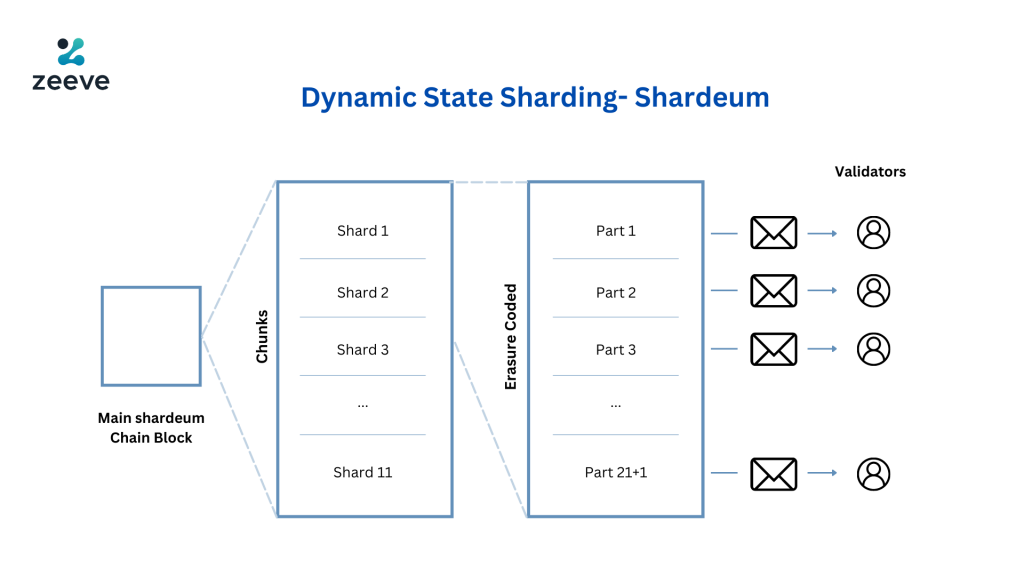
The Shardeum network continues to improve over time. Having reached the milestone of 1.5+ million total transactions and 45K smart contracts running on Liberty, Shardeum recently evolved into Sphinx. The Sphinx 1.X version of Shardeum is the final TetsNet before Shardeum rolls out the mainnet in Q2, 2023. Knowing that Shardeum has advanced features and is designed for the future, investors and web3 enthusiasts worldwide are preparing to participate in Shardeum Sphinx by testing deployment on Shardeum Testnets and Betanet, thereby leveraging benefits as active validators, stakers, and DAO members.
Benefits of operating a Shardeum validator
Shardeum provides a range of benefits to the network’s validators. It authorizes validators to perform consensus on the transaction level, earn testnet SHM for validating the transactions, and gain experience validating on an advanced, Layer-1 blockchain. Since Shardeum has evolved into Sphinx, let’s learn what validators can do on this betanet:
- Run a validator without requiring any permission via GUI or CLI.
- Stake SHM test tokens.
- Validate the network’s transactions to maintain unbounded security.
- Prepare the validator node infrastructure to run on Shardeum’s mainnet.
- Perform validation on a truly decentralized, future-oriented blockchain network.
Shardeum selects validators randomly from the standby nodes, letting them participate in the network consensus to validate the transactions. The network removes a few active nodes to adjust the node balance and support uniformity.
How to deploy a Shardeum validator node via easy, low-code approach
On Shardeum, anyone with validator capabilities can set up and run a validator node. While they can use conventional deployment methods given here, Zeeve removes the hassle and complexities of programming-based node setup and running via a low-code approach. Zeeve fast-forwards the node deployment through its robust web3 infrastructure optimized for performance and resilience. The platform provides deployment, monitoring, and maintenance of all the leading blockchain nodes, including Shardeum nodes. Following are the step-by-step instructions on how to deploy the Shardeum staking node.
Minimum hardware requirements:
- 250 GB SSD storage
- Quad core CPU less than 10 years old if self-hosting
- Dual core CPU works if hosted with newer Xeons / EPYC
- 16 GB of ram, 4+ GB of virtual memory recommended
- Hosting: 8 GB RAM + 8 GB Virtual Memory
With Zeeve, you do not have to worry about hardware requirements and other requisites as we manage everything for your validator node. Let’s start deploying the validator node. This deployment will be on Shardeum Sphinx 1.X. You can follow similar instructions to deploy your validator node on the Shardeum mainnet once it is live. Before we begin deployment, let’s set up the wallet to get funds from the faucet and connect to the Shardeum network ecosystem.
Setting up wallet for Shardeum
Download an EVM-compatible wallet like Metamask using this link. You will need this wallet to connect to the Shardeum Sphinx 1.X network, and to claim testnet SHM tokens from the Sphinx faucet. Knowing that 10 SHM tokens are the minimum delegation amount to run validators on Shardeum, you should request at least 10 tokens abiding by any of the ways listed here.
Once the tokens are credited to your wallet, start your validator node deployment on Zeeve. If you are new to Zeeve, create your account and confirm your email. Upon confirmation, you can access the Zeeve dashboard to manage your existing nodes or set up a new one. This guide explains creation of a new ‘Validator Node’ for Sphinx 1.X through step-by-step instructions listed below:
- Go to ‘Validator nodes’ under ‘Buy Services’ and click on the ‘Shardeum’ network to land on a page that asks you to provide node subscription details such as Cloud Type, Node Type, and Number of nodes you wish to deploy.
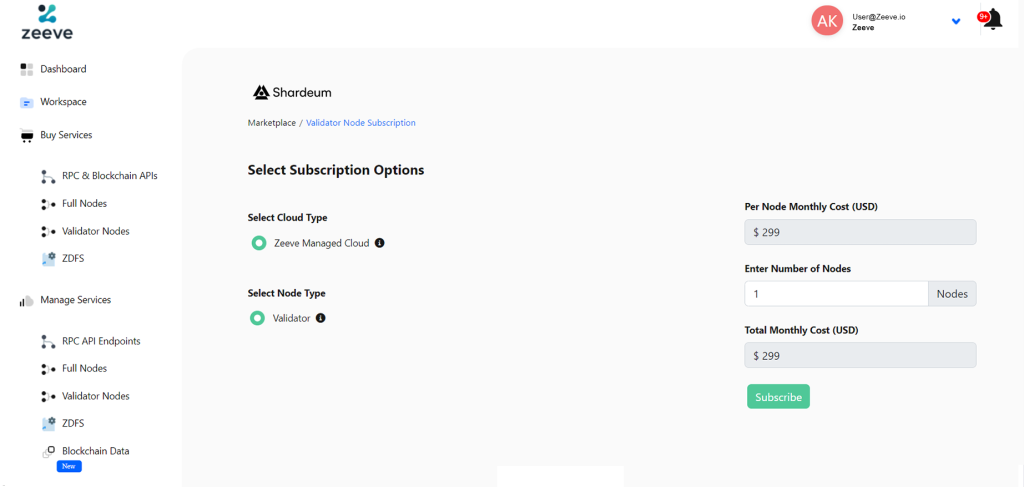
2. Once you fill in all the details, click ‘Subscribe’ and complete the payment process. Go to Managed Services —> Validator nodes and add a new Shardeum network. Add network-specific details like:
- Name of the network.
- Network type- Testnet or mainnet. (Select Sphinx for your validator node deployment)
- Deployment type.
- And, Workspace.
Click ‘Next’, and a page like the image below will open.
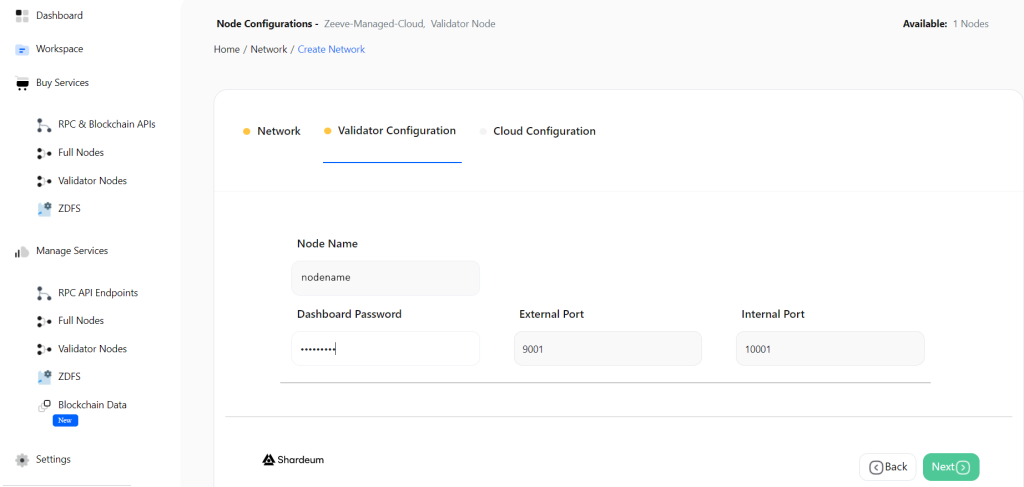
Here, you must provide three different inputs on this portal –Dashboard password, External Port, and Internal Port. Let’s quickly understand the significance of these inputs:
Dashboard password: This input is the password you choose to access the Shardeum network’s dashboard every time. Ensure to create a strong password that’s difficult to crack.
External Port: This input maintains peer-to-peer communication between all the nodes in the Shardeum network. By default, the port number is set to 9001, but you can choose between ‘1025 to 65536’ if required.
Internal Port: This is another input that maintains peer-to-peer communication across the nodes of the Shardeum Network. By default, the port number is set to 10001, but you can choose between 1025 to 65536’ if required. Click on Next and select a region relevant to your node’s geolocation. For example, we have selected ‘asia-east1’.
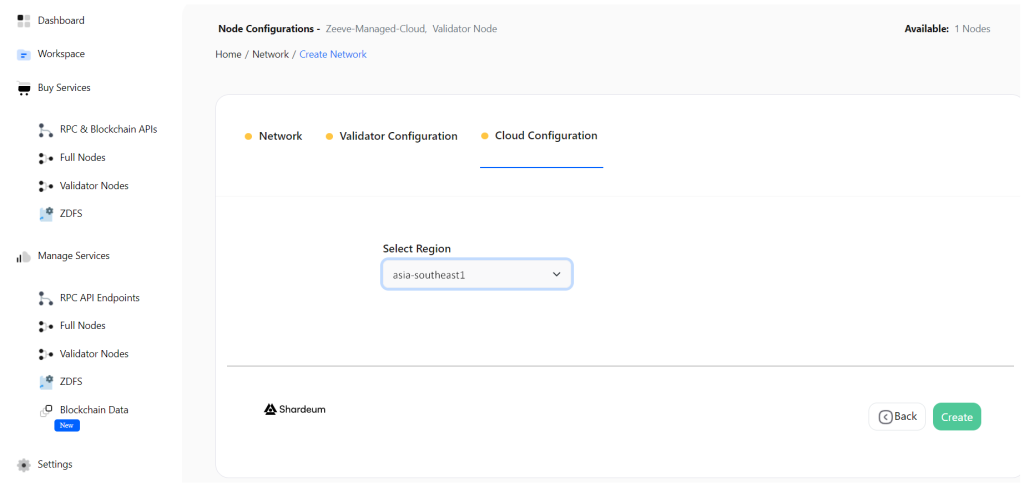
3. Click ‘Create’ to initiate the node creation process. Wait for the node to sync up to the current block height. Approximately one hour later, you will be able to access a Network Details Page displaying the Node Name, Cloud Region, Network Type, Created timestamp, and Node Status which is active. (as shown in the image below).

Staking with your validator node
- To perform staking with your validator node, you first need to open the Dashboard URL given on the Network Details Page. Once you open the dashboard, it will prompt you to enter the password you generated during the node creation process.
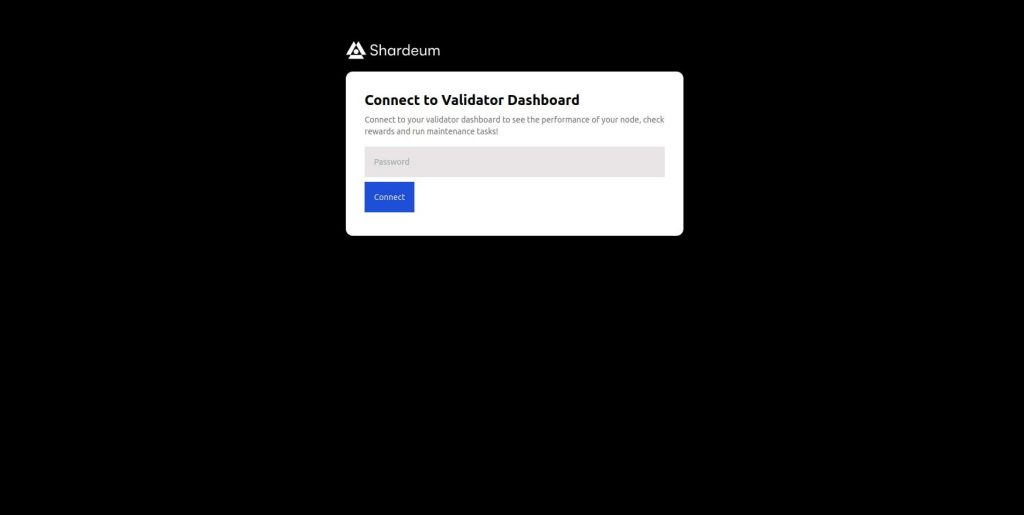
2. With the correct password, you will be granted access to the Shardeum Dashboard, consisting of multiple tabs; overview, performance, maintenance, network, Alert info, and Settings.

Navigate to the maintenance tab and click the ‘Start Node’ button. Wait for the node to transition to standby, then connect your wallet. The portal will redirect you to a page like the one below, where you can add a stake of a minimum 10 SHM tokens to begin earning the rewards and participate in the Shardeum network’s consensus.
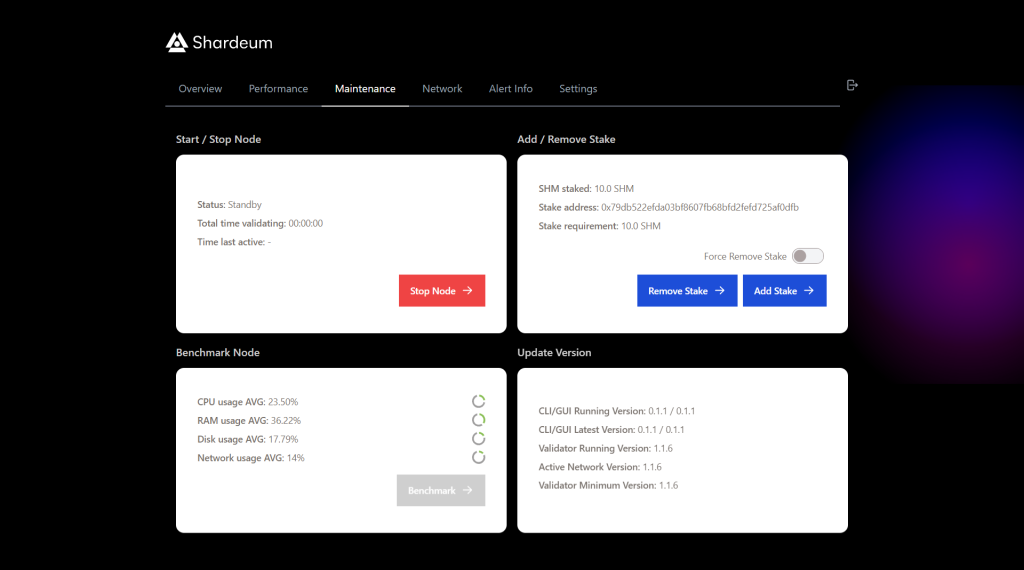
Node Monitoring & Analytics
Zeeve provides 24*7 advanced node monitoring to ensure your Shardeum validator node is healthy and actively running forever. Also, the monitoring dashboard sends predictive alerts on potential node failure so that issues can be fixed beforehand and the node never goes down. As you can see in the below image, the dashboard shows Shardeum node-specific monitoring parameters such as CPU usage, RAM usage, Swap used, and Root FS used.
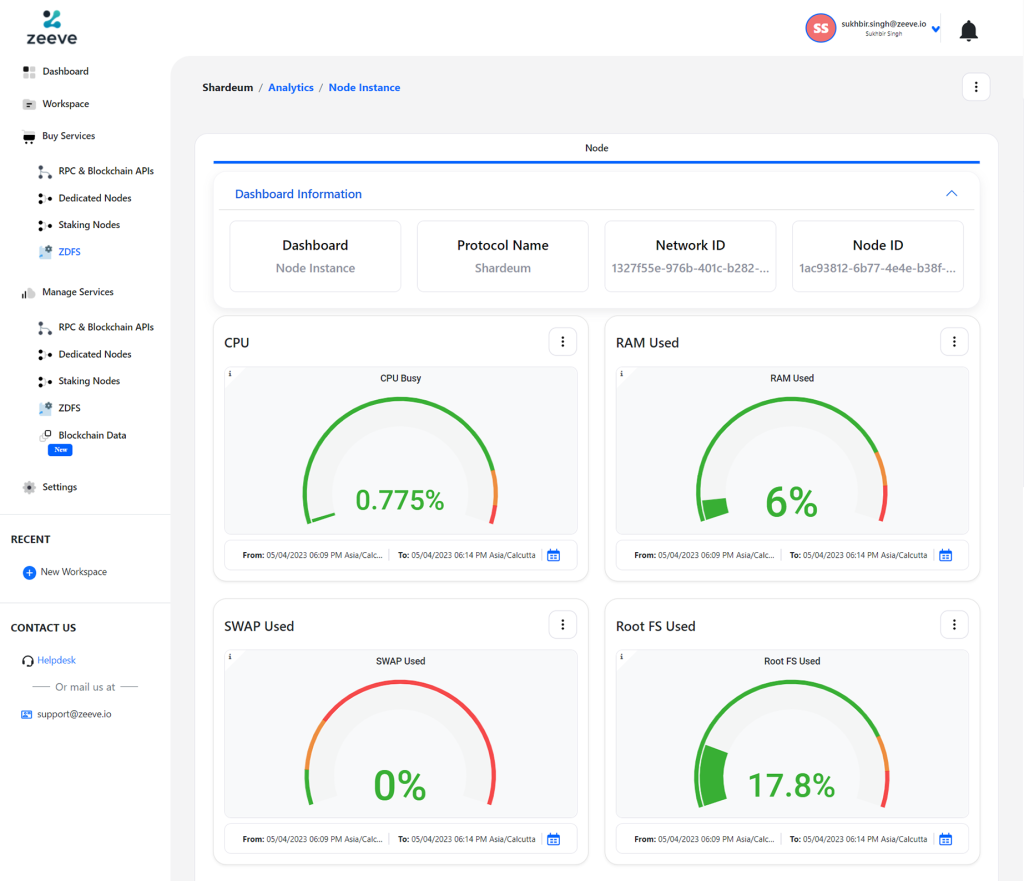
The dashboard also displays the Network traffic, Memory Stack, and total consumed disk space. All these parameters help you identify the node’s health status to maintain the high performance of nodes and eliminate the issues that lead to downtime.
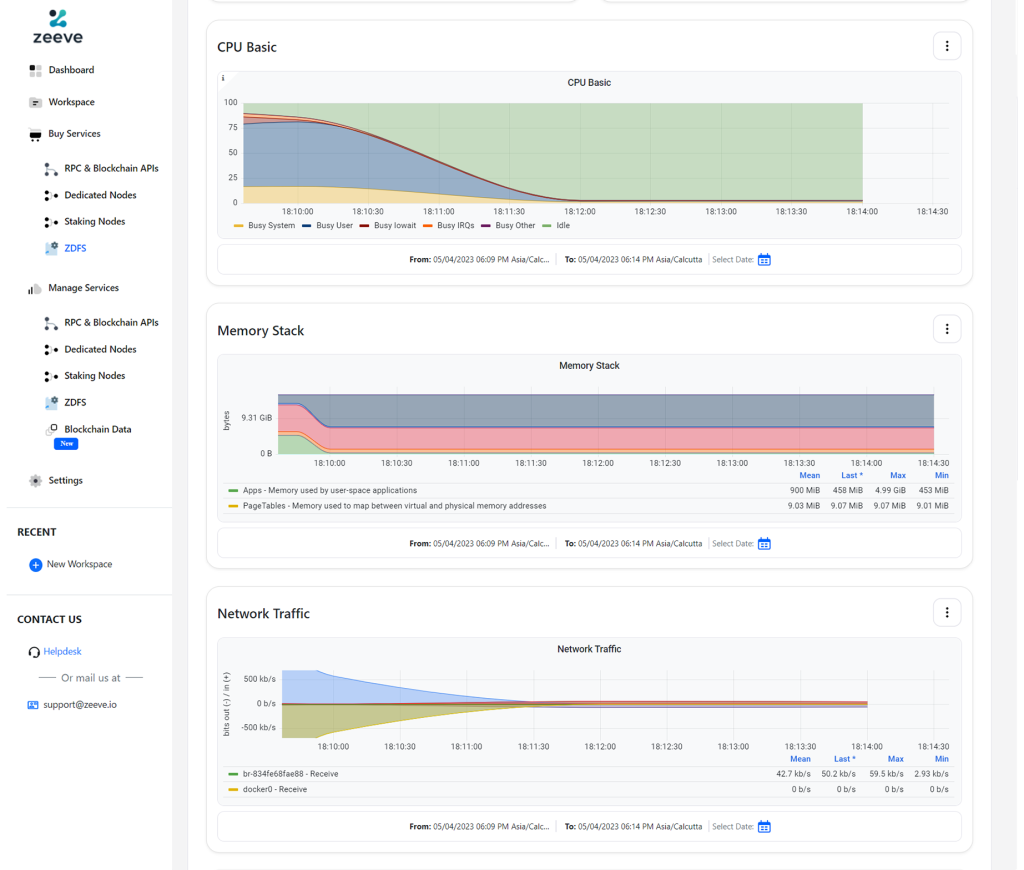
Finishing up
As discussed, nodes on Shardeum are kept on Standby, and validators are selected randomly in proportion to the network load. Hence, there’s a strong chance that your staking node will take some time to join the active validator node-set. After that, you can start validating transactions on the Shardeum network and earning staking rewards.
Leveraging Zeeve’s robust node management infrastructure and low-code node deployment platform, anyone can deploy and run all white-labeled Shardeum nodes– dedicated/full node, archived, and validators node within minutes. With high security, consistent monitoring, and a purely non-custodial form of staking, Zeeve lets you remain free from security threats and nod health-related issues while maintaining full ownership of wallets, funds, and private keys through implementing non-custodial wallets. We only manage and upgrade the underlying node infrastructure without accessing sensitive data related to your node.
Need more details on Shardeum validator nodes? Want to discuss your project requirements? Connect with our web3 consultants today and see how Zeeve can simplify your Shardeum deployment experience. Also, you can explore our active developer community on telegram.


